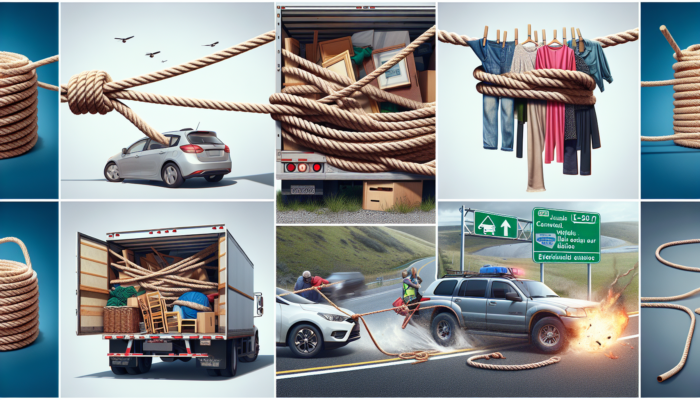Enhance Your Wilderness Survival Skills with Versatile Applications of Survival Rope
Survival ropes are essential tools for anyone venturing into the wilderness, providing a multitude of critical survival rope applications that are vital for enduring harsh conditions and emergencies. By mastering these various survival rope applications, you can significantly improve your chances of thriving in challenging scenarios. Being proficient with this adaptable tool allows you to construct shelters, perform rescues, and secure vital resources, ensuring your survival in the great outdoors.
Construct Life-Saving Emergency Shelters with Rope and Natural Materials

Finding yourself lost in the wilderness necessitates the urgent construction of an emergency shelter, which is crucial for protection against the elements and maintaining warmth. A survival rope is integral to the building process of this essential refuge. Start by selecting a suitable location—opt for a flat area free of hazards like falling branches or flood-prone zones, which can jeopardize your safety.
Next, gather natural materials such as branches, leaves, and ferns. Use the rope to create a sturdy frame for your shelter, securely tying the ends of branches together to form a structure robust enough to support additional materials. A popular design is the A-frame shelter, where two long branches are arranged in a V-shape, with the rope effectively securing the apex to enhance stability.
Cover the frame with branches or large leaves, using the rope to fasten them securely and create a protective barrier against wind and rain. This construction not only provides insulation but also helps in retaining warmth while keeping moisture at bay. A well-constructed shelter can be the pivotal factor between survival and exposure to inclement weather, highlighting the importance of survival rope applications in wilderness settings.
Master Improvised Rescue Techniques Using Rope to Aid Others in Distress
In emergency situations where you or someone else requires assistance, understanding how to effectively utilize a survival rope for improvised rescue techniques can be a life-saving skill. One effective method is crafting a harness from the rope. If an individual falls or becomes incapacitated, you can fashion a makeshift harness by looping the rope around their torso and securing it with strong knots, which can facilitate their safe extraction.
For self-rescue, if you find yourself in a precarious position, such as on a steep incline, you can establish a belay system using your rope. Attach one end to a secure anchor point, like a sturdy tree, while using the other end to secure yourself as you climb or navigate. This technique not only minimizes the risk of falls but also aids your movement through challenging terrains.
Additionally, the rope can be anchored to a stable object to create a pulley system, which is particularly useful for lifting injured individuals or heavy items. By applying principles of leverage and friction, you can efficiently transport a person or object to safety, showcasing the remarkable adaptability of survival rope applications in critical emergency scenarios.
Innovative Methods for Water Collection and Filtration Using Rope to Secure Clean Drinking Water
Water is an essential resource for survival, and being equipped with the knowledge of how to collect and purify it is crucial in wilderness settings. A survival rope can significantly assist in both gathering and effectively filtering water. To collect water, create a makeshift container by tying a piece of cloth or clothing to the end of the rope, lowering it into a water source, and then retrieving it filled with liquid.
For the filtration process, the rope can be utilized in combination with natural materials. After collecting water, devise a simple filtration system by tying the rope to a container and layering it with sand, charcoal, and gravel. Pour the collected water through this setup; the natural materials will effectively filter out impurities, yielding cleaner drinking water that is safe for consumption.
Additionally, if you are in an area experiencing dew or rainfall, use the rope to suspend a collection device. Tie the rope between two trees and hang a container beneath it to catch moisture as it drips down. These innovative techniques illustrate the resourcefulness that a survival rope can provide in critical situations, ensuring access to clean drinking water when it is most needed for your survival.
Everyday Applications of Survival Rope: Versatile Uses Beyond Wilderness Survival

While the survival rope applications are often emphasized in wilderness contexts, this multifaceted tool proves equally valuable in everyday life. From home improvement projects to emergency repairs, the applications of rope are extensive and diverse, enhancing its utility in daily routines.
Utilizing Rope for Home and Garden Projects: Effective Applications Around Your Living Space
In the realm of home and garden projects, survival rope can be an invaluable resource. For gardening enthusiasts, rope can be employed to provide support for climbing plants such as tomatoes or beans. By constructing trellises with rope, you give your plants the necessary support to grow upward, maximizing vertical space while minimizing ground area occupation.
Furthermore, rope is beneficial for organizing and securing items throughout your home. Whether you need to hang tools in the garage or secure belongings in your vehicle, a sturdy rope can ensure everything remains in place. For instance, using rope to fasten a load in a truck bed prevents shifting during transport, guaranteeing that your possessions arrive safely at your destination.
Moreover, rope can be creatively incorporated into your interior design projects. Crafting wall hangings or unique light fixtures using rope adds rustic charm and character to any room. This application not only showcases the versatility of survival rope applications but also invites creativity into your everyday life, enhancing the aesthetic and functional aspects of your living space.
Emergency Vehicle and Boat Maintenance: The Crucial Role of Rope for Quick Repairs
In the context of vehicle and boat maintenance, a survival rope serves as a vital tool during emergencies. On the road, if you experience a breakdown, rope can temporarily secure loose components until permanent repairs can be made. For example, if a bumper is hanging off, a sturdy rope can hold it in place until a mechanic can address the issue, ensuring you remain safe while awaiting assistance.
Within boating contexts, rope is essential for securing equipment and ensuring safety while on the water. If a line breaks, knowing how to swiftly tie a new line can prevent accidents and maintain the integrity of your vessel. Furthermore, using rope for mooring ensures that your boat remains securely in position, especially during turbulent waters, enhancing your safety while navigating.
Additionally, ropes can assist in towing another vehicle or boat. By establishing a secure connection, you can safely pull a stranded vehicle or help a fellow boater in distress. Understanding these everyday survival rope applications enhances your preparedness for any situation, whether on land or at sea, ensuring you are equipped to handle unexpected challenges.
Outdoor Sports and Activities: Maximize Your Adventures with Versatile Rope Uses

The versatility of survival rope applications truly shines in outdoor sports and activities. When camping, a rope can be employed to suspend food away from wildlife, effectively preventing animals from accessing your provisions. A simple knot can secure your food bag high in a tree, ensuring it remains safe from curious critters and reducing the risk of attracting unwanted attention.
For hiking, a survival rope can assist in creating a makeshift handrail on steep trails. By tying a rope to sturdy trees or rocks, you provide additional support as you navigate challenging terrain. This not only enhances your safety but also boosts your confidence in tackling difficult paths, making your hiking experience more enjoyable.
In climbing, the significance of a robust survival rope cannot be overstated. It is essential for belaying, rappelling, and securing both yourself and your gear. Mastering the effective use of a rope in climbing scenarios can be life-saving, allowing you to explore new heights while minimizing risks and ensuring your safety throughout your climbing adventures.
Selecting and Caring for Your Survival Rope for Optimal Performance
Choosing the right rope for your specific survival needs is paramount for maximizing its effectiveness during critical situations. Understanding the various types of ropes and their unique applications can profoundly impact your success in survival scenarios.
Identify the Ideal Rope for Your Survival Requirements – Understand Different Types and Their Uses
When selecting a survival rope, there is a multitude of options available, each with unique characteristics suited for specific tasks. Paracord is a favored choice due to its impressive strength and versatility. Made from nylon, it can support significant weight, making it ideal for a variety of survival tasks ranging from shelter construction to emergency repairs.
Another option is climbing rope, which is specifically designed for climbing and mountaineering. These ropes are usually thicker and possess a higher tensile strength, ensuring safety in high-risk environments. Understanding the specific applications of each type of rope helps guarantee you choose the most appropriate tool for your situation, enhancing your overall preparedness.
For lighter tasks, utility rope may suffice. These ropes are perfect for everyday uses, such as securing items at home or participating in recreational activities like boating. Ultimately, knowing the distinctions between these ropes and their durability empowers you to make informed decisions, ensuring you have the right tools for your survival kit.
Implement Effective Rope Maintenance and Storage Techniques for Longevity and Reliability
Maintaining your survival rope is essential for preserving its strength and extending its lifespan. After each use, conduct a thorough inspection for signs of wear and tear. Look for fraying, cuts, or discoloration, as these can indicate that the rope’s integrity has been compromised, signaling a need for replacement to avoid unforeseen failures.
Proper storage is equally critical. Store your rope in a cool, dry environment away from direct sunlight, as UV rays can degrade the material over time, reducing its effectiveness. It is advisable to coil your rope neatly to prevent tangles and kinks, which can weaken the rope and hinder its functionality when needed.
When not in use, consider placing your rope in a protective bag or container to shield it from moisture and dirt. Keeping your rope clean will ensure that it remains functional for years to come. By adhering to these maintenance recommendations, you can prolong the life of your survival rope and ensure that it remains a reliable tool in your survival arsenal.
Essential Safety and Handling Practices for Rope Use – Minimize Risks While Maximizing Effectiveness
Safety should always be a top priority when utilizing a survival rope. One of the most critical practices is to double-check your knots and connections before applying any weight to the rope. A poorly tied knot can lead to catastrophic failures, particularly in high-stakes scenarios like climbing or rescue operations where lives are on the line.
When handling rope, remain aware of your surroundings. Exercise caution around sharp edges or rough surfaces that could damage the rope. Additionally, avoid exposing your rope to chemicals or extreme temperatures, as these factors can weaken the fibers and compromise performance, putting you at risk during critical moments.
Familiarizing yourself with the specific knots and techniques relevant to your activities is another essential safety practice. Whether it’s climbing, fishing, or securing items, knowing how to execute the proper knots ensures that your rope performs reliably when needed most. By following these safety and handling tips, you can maximize the effectiveness of your survival rope applications while minimizing risks and ensuring your safety.
Become Proficient in Knots and Rigging Techniques for Superior Rope Utilization
Knots and rigging techniques are fundamental skills that every survivalist must master for effective use of rope. The ability to tie the right knot can significantly influence your success in various survival situations, enhancing your overall preparedness.
Essential Knots Every Outdoor Enthusiast Should Master to Boost Survival Skills
In the world of survival, mastering a few essential knots can prove incredibly advantageous. One of the most versatile knots is the bowline knot, renowned for its ability to create a secure loop at the end of a rope. This knot is particularly useful in rescue scenarios, as it remains secure and does not slip under pressure, providing a reliable connection.
Another vital knot is the taut-line hitch, which allows for easy adjustments of rope tension. This knot is especially beneficial for securing tarps or tents, ensuring they remain taut even in windy conditions, thus protecting you from the elements and enhancing your comfort.
The clove hitch is also an important knot for securing items or joining two ropes together. Its simplicity in tying and untying makes it ideal for quick applications. Understanding these crucial knots and their uses can dramatically enhance your survival skills, ensuring you are well-prepared for any situation that may arise during your outdoor adventures.
Advanced Rigging Techniques for Complex Situations: Explore Expert Methods for Challenging Environments
For those looking to elevate their rope skills, advanced rigging techniques can unlock a world of possibilities. One such technique involves using a pulley system, which facilitates the lifting of heavy objects or individuals with minimal effort. By integrating pulleys with your ropes, you can effectively distribute weight and reduce the strain required to move items.
Utilizing a double fisherman’s knot allows you to securely connect two ropes, creating longer lengths when necessary. This is particularly advantageous in rescue scenarios where longer ropes are needed to reach individuals in distress, enhancing your ability to perform lifesaving actions.
Moreover, mastering how to rig a tensioned line can assist in various applications, from creating a clothesline to setting up a highline for crossing gaps. Although advanced rigging techniques can be intricate, mastering them equips you with valuable skills for effectively navigating complex environments and emergencies.
Crafting Improvised Tools and Devices with Rope – Create Useful Instruments with Common Items
The ingenuity involved in using a survival rope extends to crafting improvised tools and devices that can significantly enhance your survival capabilities. One common application is designing a fishing trap. By weaving rope into a net-like structure, you can create a simple trap for catching fish or small game, which can substantially improve your food-gathering capabilities in the wild.
Another valuable device is a makeshift stretcher. By securing two sturdy poles with rope, you can construct a stretcher for transporting an injured person. This is especially crucial in emergencies where swift movement is vital, allowing for efficient evacuation from danger.
Additionally, a rope can be fashioned into a simple slingshot using a sturdy Y-shaped branch and elastic materials. This tool can serve as an effective means of hunting small game or as a signaling device in distress situations. The possibilities are endless when it comes to improvising tools with rope, showcasing the inventive spirit that can facilitate survival.
Practical Tips for Urban and Wilderness Survival Using Rope
Regardless of whether you find yourself in an urban environment or the wilderness, the versatility of survival rope applications can be invaluable in various survival scenarios. Knowing how to leverage these techniques ensures you are prepared for any situation that may arise, enhancing your overall readiness.
Urban Survival: Effective Rope Uses for Emergency Preparedness in City Environments
In urban settings, the potential for emergencies is a constant concern. Understanding how to effectively employ a survival rope can greatly enhance your emergency preparedness. For instance, in the event of an evacuation, a rope can be utilized to secure your belongings, facilitating swift transport to safety without leaving crucial items behind.
Rope can also be employed to create makeshift barriers or secure doors and windows following a disaster. By tying a rope around door handles or window frames, you can deter intruders and safeguard your space until help arrives, providing you with peace of mind during uncertain times.
Moreover, knowing how to use rope for climbing can be critical if you need to navigate through damaged buildings or escape from elevated structures. Proficiency in these urban survival techniques not only boosts your confidence but also enhances your overall preparedness for emergencies, ensuring you can act decisively when needed.
Wilderness Navigation and Signaling: Utilizing Rope for Safety and Effective Communication
In wilderness scenarios, survival rope applications extend to navigation and signaling, enhancing your chances of being rescued. If you become lost, using rope to mark your trail can help prevent disorientation. By tying small pieces of cloth or other markers to the rope, you create a visual guide that aids in retracing your steps, ensuring you can find your way back.
For signaling, a rope can be employed to create large symbols or patterns that are visible from the air. By laying the rope in a clear area to spell out “HELP” or another recognizable signal, you significantly increase your chances of being spotted by search and rescue teams, facilitating a quicker response.
Additionally, using rope to fashion a hammock can provide a safe resting place while awaiting assistance. Elevating yourself off the ground not only keeps you comfortable but also protects you from insects and potential predators, exemplifying the multifaceted applications of survival rope applications in wilderness navigation and communication.
Enhancing Foraging and Hunting Skills with Rope – Efficiently Gather Food and Resources in the Wild
Foraging for food and resources in the wild can be significantly improved through the clever use of a survival rope. One application includes creating traps for small game. By utilizing rope to fashion snares or deadfalls, you can enhance your chances of successfully capturing food, ensuring a reliable source of nutrition.
Rope can also assist in gathering wild edibles. If you come across fruit-bearing trees or shrubs, a sturdy rope can help you reach higher branches. By tying a container to the end of a long rope, you can pull down fruit without the need to climb, making foraging both efficient and safer.
Moreover, using rope to carry gathered resources can alleviate your burden. By creating a makeshift backpack with rope and fabric, you can securely transport food back to your camp, minimizing strain during your foraging expeditions. These practical applications underscore the versatility of survival rope applications in enhancing your ability to gather food and resources effectively.
Expert Insights on Survival Rope Applications: Frequently Asked Questions
Addressing Common Inquiries About the Use of Survival Rope
What is the best type of rope for survival situations?
The best type of rope for survival situations is typically paracord, known for its strength, versatility, and lightweight nature. It can be employed for a myriad of applications, from constructing shelters to securing gear, making it an invaluable asset in survival kits.
How do I maintain my survival rope?
To care for your survival rope, perform regular inspections for wear and tear, store it in a cool, dry location, and avoid exposure to UV light or harsh chemicals. Proper maintenance will prolong its lifespan and ensure reliability when you need it most.
Can I use regular rope for survival situations?
While regular rope can be utilized, it may not provide the same strength and durability as specialized survival ropes like paracord or climbing rope. Always choose a rope that is suited to your specific needs and survival requirements.
What knots should I learn for survival?
Essential knots for survival include the bowline knot, taut-line hitch, and clove hitch. Mastering these knots will enhance your ability to secure items and create makeshift tools, significantly boosting your survival effectiveness.
How can I use rope for water collection?
Rope can be employed to create a makeshift container by tying a cloth to it and lowering it into a water source. Additionally, it can help suspend collection devices to capture rainwater, ensuring access to hydration in survival scenarios.
What safety practices should I follow when using rope?
Always double-check knots before use, avoid sharp edges, and familiarize yourself with the specific knots related to your activities. Implementing safety practices minimizes risks and ensures reliable performance when it matters most.
How do I create a shelter using rope?
To construct a shelter, use rope to tie together branches or poles, forming a frame. Drape additional materials over the frame and secure them with the rope to establish a stable structure that protects against the elements.
Is it safe to use rope in climbing?
Yes, using specialized climbing rope is safe when properly maintained and utilized with the correct knots and techniques. Always ensure that your equipment is in good condition before attempting to climb, prioritizing your safety.
Can I use rope for signaling in the wilderness?
Yes, rope can be used to create large symbols or patterns that are visible from the air, significantly increasing your chances of being located by search and rescue teams in wilderness settings.
What improvised tools can I craft with rope?
You can create various improvised tools with rope, including fishing traps, stretchers for transporting injured individuals, and even slingshots for hunting small game, showcasing the versatility of survival rope.
The post Survival Rope Uses: Conquer the Great Outdoors appeared first on Survival Bite.
The Article Survival Rope Uses for Thriving in the Great Outdoors Was Found On https://limitsofstrategy.com


Your exploration of survival rope applications truly sparked some thoughts for me! It’s fascinating how versatile such a simple tool can be in a wilderness setting. I remember my first hike in a remote area, and I had thought that safety gear wasn’t necessary beyond a good pair of boots and water. Little did I know how crucial it would be to have the right tools when I found myself in a torrential downpour, seeking refuge.
It’s interesting how those first experiences in the wilderness can really shift our perspectives on safety and preparedness. I remember my own first hike—thinking I could get by with just the essentials until I faced unexpected weather changes. It really drives home the importance of having the right gear, like a solid survival rope. It’s amazing how something seemingly simple can become a lifeline in challenging situations.
Your experience resonates with many of us who have ventured into the wilderness for the first time. It’s those unpredictable moments—like sudden downpours or gusty winds—that really open our eyes to just how quickly conditions can shift. I remember my first outdoor adventure, too. I had my list of essentials, but nothing prepared me for a chilly evening that crept in sooner than expected. That moment of realizing I wasn’t as ready as I thought became a lesson in the importance of thorough preparation.
It’s interesting how our experiences define what we think we might need in the wild. That first hike can be a real eye-opener. The unexpected downpours or sudden changes in the weather really bring home the importance of being prepared. A survival rope might seem like an afterthought, but in those moments, it can be a lifeline—literally and figuratively.
You’re right; those first hikes can really reshape our understanding of what it means to be prepared in the wild. I remember my first solo hike—clear skies turned into a surprising downpour that soaked me to the bone. It was a harsh lesson in the unpredictability of nature. Suddenly, I was reflecting on every choice I made packing my bag, and that survival rope became a focal point in my mind. It’s incredible how something so simple can symbolize safety, right?
It’s interesting how those early experiences shape our understanding of what we really need in the outdoors. I can relate to that feeling of overconfidence in staying light—like the first time I ventured out thinking I’d be fine with just the basics. Encountering unexpected weather really does highlight the need for reliable gear.
It’s so true—those early experiences really do teach us some hard lessons. I remember my first overnight trip with just a sleeping bag and a rain jacket, thinking I could tough it out. Then the skies opened up, and all I had was soggy sandwiches and a growing sense of dread. It really hits home how crucial reliable gear is, especially when Mother Nature decides to throw a curveball.
“Absolutely, those moments remind us how crucial it is to be prepared. If you’re looking to upgrade your gear for any adventure, check out this selection of reliable equipment that can truly make a difference.”
https://enfieldlink.org/emailoctopus
I can totally relate to that experience. It’s funny how those moments of discomfort stick with us long after they happen. I remember my first solo camping trip, where I thought I could just rely on a thrift store tent and whatever I had lying around. The weather turned, just like you mentioned, and suddenly it felt more like survival than a getaway.
It’s interesting how those unexpected moments in nature really shape our perspective on safety, right? Your experience in the torrential downpour is a great reminder that even the simplest hiking trips can take a turn when the weather decides not to play nice.
It’s true how those unexpected moments in nature can really shift our perception of safety. When I was caught in that torrential downpour, it struck me how quickly things can change out there. One minute, the sun is shining, and the trail feels manageable, and the next, you’re navigating through a downpour that makes every step feel uncertain. It’s a vivid reminder of how unpredictable nature can be, and how essential it is to respect it.
Absolutely, those surprising elements in nature can really shift our outlook! If you’re looking to prepare for any unexpected situations on your adventures, check out this helpful guide on essential hiking gear that can keep you safe and ready for anything.
https://enfieldlink.org/emailoctopus
I really appreciate the emphasis you placed on the versatility of survival ropes in wilderness scenarios. It’s interesting how such a simple tool can hold so many critical applications when you’re out in the wild. In my experience, it’s not just about having the survival rope, but understanding how best to use it that can make all the difference when things go sideways.
You raise a great point about the importance of understanding how to use a survival rope effectively. It’s fascinating how a tool that seems so straightforward can actually be a game-changer in a crisis. I remember a camping trip where I had to set up an emergency shelter. I realized that it was not just about having the rope but knowing the right knots and techniques to secure everything properly.
Your experience really highlights an essential aspect of using a survival rope—it’s not just about having the right equipment, but it’s also about the skills that come with it. Setting up an emergency shelter can be stressful, and knowing how to tie those knots correctly can make all the difference between a difficult night and a relatively comfortable one.
You make a great point about the importance of not just having a survival rope, but truly understanding how to use it effectively. It’s easy to underestimate something that seems straightforward, but the nuances in its application can be a game changer in challenging situations.
Absolutely, understanding the various techniques for using survival ropes is essential. If you’re looking to deepen your skills, check out this comprehensive guide that explores different methods and applications for survival ropes in the wild!
https://enfieldlink.org/VideoLeap
You really hit the nail on the head with your thoughts on survival ropes. It’s so true that while the concept seems simple, the real skill lies in knowing the different techniques and knowing when to apply them. In high-pressure situations, that understanding can make all the difference.
Thank you for your thoughtful comment! To expand your knowledge even further, I highly recommend checking out this insightful guide that dives into essential techniques and applications for using survival ropes effectively in the wild. You can find it here: [link].
https://enfieldlink.org/ParentAler